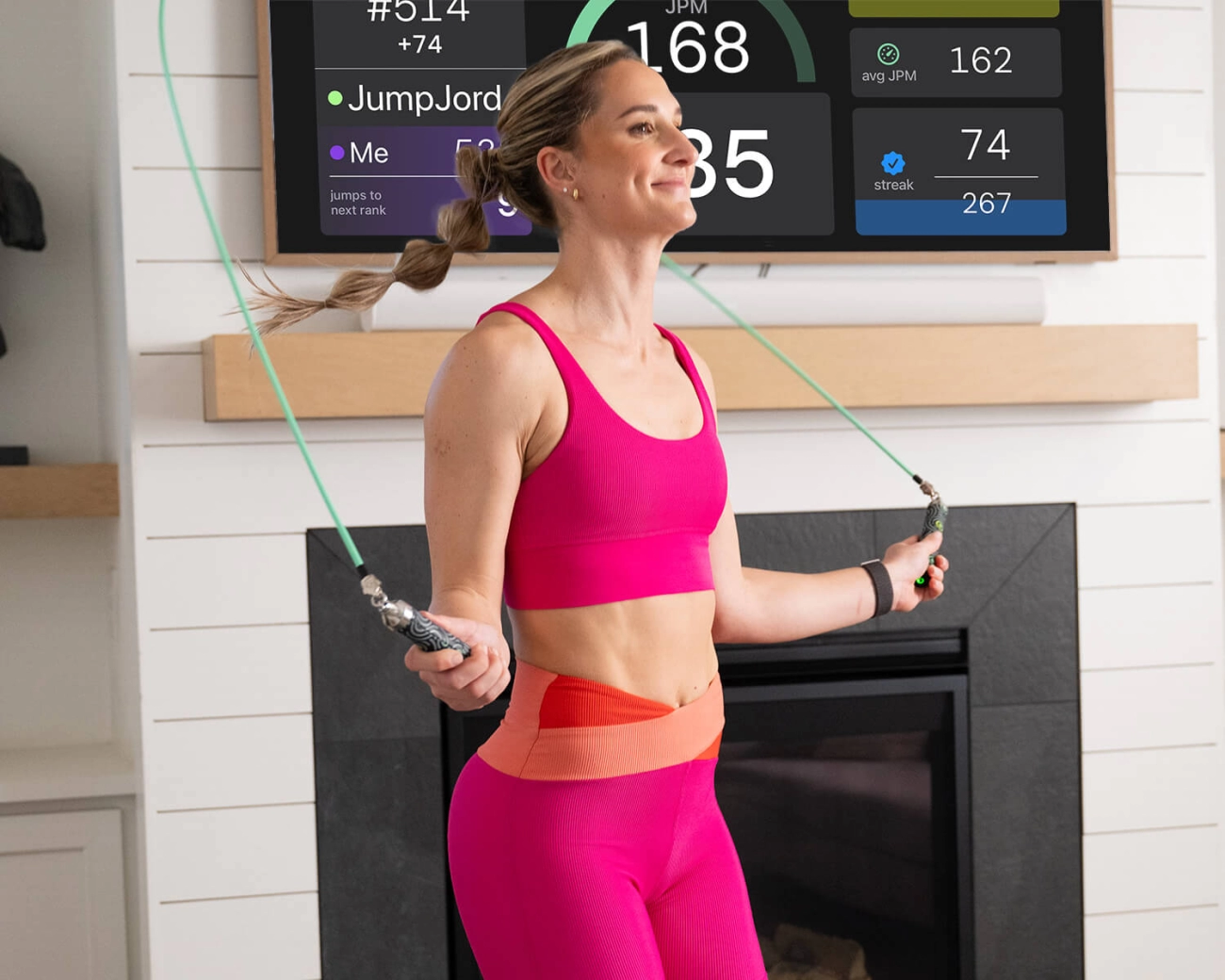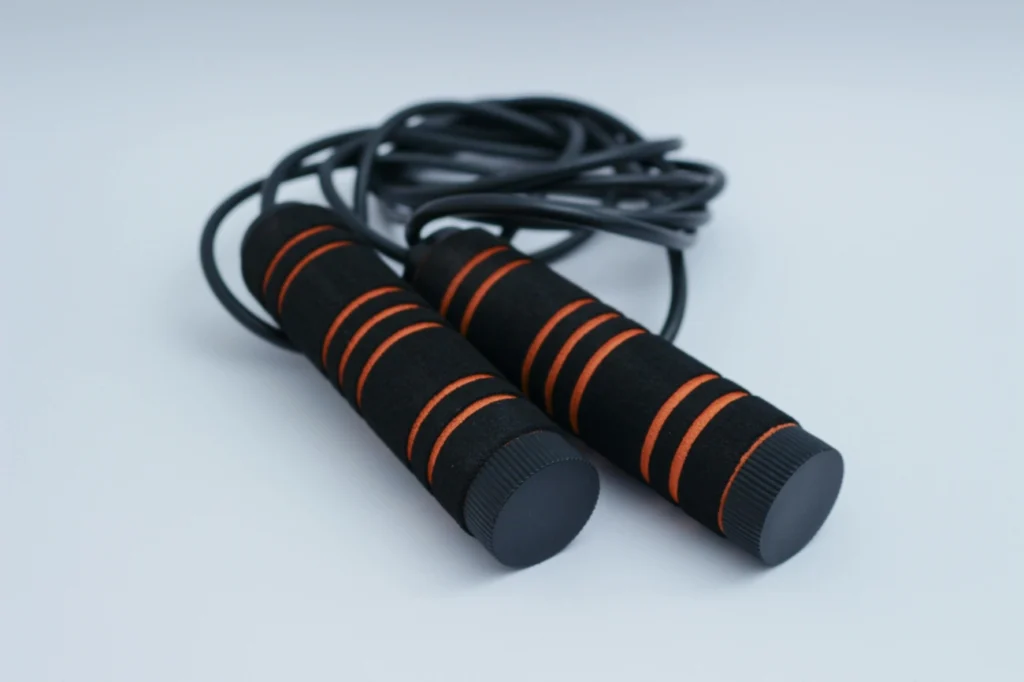What is Skipping Rope
Skipping rope, also known as jump rope, is a simple yet highly effective form of exercise that has been used for decades across sports, fitness, and recreation. While it might seem like a playground pastime, skipping rope is a staple in boxing training, HIIT workouts, and cardio conditioning because it builds agility, endurance, and coordination.
Definition and Historical Context
Skipping rope dates back centuries, with evidence of rope-jumping games found in ancient civilizations. It became popularized as both a children’s activity and a serious athletic tool during the early 20th century. Over time, it evolved from basic cotton ropes to advanced, specialized equipment used by competitive athletes and fitness enthusiasts worldwide.
Types of Jump Ropes and Equipment
The right equipment can make a big difference in performance. Common types include:
- PVC Jump Ropes – Fast, durable, and ideal for speed work or HIIT training.
- Beaded Jump Ropes – Heavier, offering better rhythm control for beginners and freestyle tricks.
- Adjustable Jump Ropes – Allow customization of rope length for different heights and workout styles.
- Weighted Jump Ropes – Increase muscle engagement in the arms, shoulders, and core.
Key features to consider:
- Length – The rope should reach armpit height when stepped on.
- Handles – Ergonomic grips with smooth bearings for rotation efficiency.
- Material – PVC, leather, steel cable with coating, or beads depending on speed, durability, and workout focus.
Basic Skipping Rope Techniques
While skipping rope looks straightforward, mastering form maximizes benefits and minimizes injury risk. A basic technique involves:
- Holding handles lightly at hip level.
- Jumping just high enough for the rope to pass under (about 1–2 inches off the ground).
- Landing softly on the balls of the feet to reduce impact.
- Maintaining an upright posture with a relaxed upper body.
Once comfortable, users can advance to double-unders, crossovers, and side swings for variety.
Common Uses for Skipping Rope
Jump rope training is incredibly versatile and effective for:
- Cardio workouts at home or outdoors – Burns high calories in minimal time.
- Coordination and footwork drills – Widely used in sports like boxing, MMA, and basketball.
- HIIT sessions – Alternating fast bursts with short rests for fat loss and stamina.
- Warm-ups – Quickly elevates heart rate before strength training or sports practice.
Skipping rope remains one of the most portable and cost-effective fitness tools, making it a favorite for both beginners and elite athletes looking to improve speed, agility, and endurance.
What is Rebounding

Definition of Rebounding
Rebounding is a fitness workout performed on a mini-trampoline, often called a rebounder. It involves gentle to vigorous bouncing motions that keep your feet in constant or near-constant contact with the trampoline surface. Unlike outdoor trampolining for tricks, rebounding is designed for low-impact cardio, balance training, and lymphatic health.
Types of Rebounders and Sizes
Rebounders come in a few styles, with differences in frame size, mat tension, and foldability. Common options include:
- Standard rebounders – About 36″–48″ in diameter, sturdy steel frame, non-foldable.
- Folding rebounders – Easier to store, great for small spaces.
- Bungee-style rebounders – Softer bounce, quieter than spring models, less jarring on joints.
- Spring rebounders – Slightly firmer bounce, often lower cost but a bit noisier.
Basic Rebounding Techniques and Workouts
You don’t need advanced skills to start rebounding. Popular moves include:
- Health bounce – Gentle, low-height bounce for warm-up or recovery.
- Jogging in place – Boosts heart rate without heavy joint stress.
- Twist and bounce – Engages core muscles while improving agility.
- Jump jacks – Cardio move with full-body engagement.
Rebounding workouts can range from light mobility routines to high-intensity cardio sessions depending on fitness level.
Uses and Popularity in Fitness and Rehabilitation
Rebounding is widely used because it’s low impact, easy on joints, and burns calories without pounding the knees or hips. It’s especially popular for:
- Cardiovascular training at home.
- Post-injury rehabilitation and balance retraining.
- Lymphatic circulation improvement—the bounce motion helps stimulate the body’s natural detox process.
- Older adults or those with mobility concerns who want safe, joint-friendly movement.
In the U.S., rebounding has gained attention as a compact, indoor-friendly workout that works well for small spaces, is quiet, and is easy to combine with other fitness routines.
Comparison Skipping Rope vs Rebounding
Calorie Burn and Cardiovascular Benefits
Both skipping rope and rebounding are solid cardio workouts, but skipping rope typically burns more calories per minute because it’s a high-intensity, full-body activity. On average:
| Activity | Calories Burned (30 min)* | Intensity Level |
|---|---|---|
| Skipping Rope | 300–450 | High |
| Rebounding | 150–250 | Moderate |
*Based on a 155 lb adult, effort level varies.
- Skipping Rope: Quickly spikes your heart rate, making it great for endurance and HIIT workouts.
- Rebounding: Still boosts cardiovascular health, but at a lower, joint-friendly intensity.
Impact on Joints and Injury Risk
- Skipping Rope: Higher-impact due to landing force; requires proper form and cushioned flooring to avoid shin splints or knee strain.
- Rebounding: Low-impact thanks to trampoline surface, which absorbs shock. Safer for older adults or those with joint pain.
Tip: If you have knee or hip issues, rebounding may be the better choice.
Muscle Engagement and Body Toning
Skipping Rope
Works calves, quads, hamstrings, shoulders, forearms, and core.
Improves coordination, speed, agility.
Rebounding
Engages legs, glutes, abs, and stabilizing muscles of the core.
Excellent for balance and lymphatic circulation.
Quick Note: Skipping tones upper and lower body; rebounding focuses more on lower body and stability muscles.
Skill Level and Learning Curve
Skipping Rope: Steeper learning curve—timing and rhythm take some practice. Beginners can start with short intervals and basic jumps.
Rebounding: Easier to pick up; basic bouncing and marching in place are beginner-friendly.
For skipping tips, check out our guide on good skipping habits.
Space and Portability
| Factor | Skipping Rope | Rebounding |
|---|---|---|
| Space Need | Minimal; 4-6 ft overhead room | Requires floor footprint of trampoline |
| Portability | Highly portable; fits in bag | Not portable; bulky to move |
If you travel or have limited space, skipping ropes (like our adjustable PVC jump ropes) are far more convenient.
Equipment Cost and Maintenance
Skipping Rope: $10–$30 for quality ropes, minimal upkeep.
Rebounding: $80–$300+ depending on brand/size; requires proper storage and occasional part checks.
Versatility and Workout Variations
Skipping Rope Variations
Basic jump, high knees, double unders, side swings.
Works well in HIIT circuits and boxing routines.
Rebounding Variations
Basic bounce, twist, sprint, resistance-band arm work.
Great for steady-state cardio and active recovery days.
Some routines combine both for variety—skip for high-intensity bursts, rebound for low-impact recovery. This mix hits cardio, coordination, and joint-friendly movement in one session.
Who Should Choose Skipping Rope
Ideal Users for Skipping Rope
Skipping rope is a high-intensity option that works best for people who want speed, agility, and strong cardiovascular training. It’s a favorite for:
- Athletes – building endurance, explosiveness, and footwork.
- Boxers and combat sports – improving agility, timing, and coordination.
- HIIT enthusiasts – quick calorie burn in short bursts.
- People short on time – effective workouts in 10–15 minutes.
- Users focused on weight loss – burns major calories compared to many home workouts.
If you like fast-moving, sweat-heavy sessions, skipping rope is your go-to.
Recommended Rope Types from JumpRopeManufacturer
Choosing the right rope makes a big difference in performance. Here’s what works best based on your goal:
| Goal | Recommended Rope from JumpRopeManufacturer | Why It Works |
|---|---|---|
| Speed & agility | PVC jump ropes | Lightweight, fast rotation, great for speed work. |
| Timing & rhythm training | Beaded jump ropes | Controlled swing, more feedback for timing drills. |
| Adjustable comfort | Adjustable jump ropes | Fits any height, easy to fine-tune length. |
| Pro-level durability | OEM/ODM ropes | Built for frequent, high-intensity training. |
Common Use Cases and Routines
Skipping rope fits into different workout styles. Here are a few examples:
- Warm-Up – 2–3 minutes of moderate pace to raise heart rate.
- HIIT Circuit – 30 seconds of double-unders / 30 seconds rest for 8–10 rounds.
- Boxer’s Routine – 3 minutes skipping / 30 seconds rest (repeat 6–10 rounds).
- Endurance Build – 10–15 minutes steady pace with varied footwork.
Who Should Choose Rebounding

Rebounding, or mini-trampoline workouts, is a unique form of low impact exercise that’s easy on the joints but still delivers solid cardiovascular and body-toning benefits. It works for a wide range of fitness levels, but some groups benefit from it more than others.
Ideal Users for Rebounding
You’ll likely get the most out of a rebounder if you fall into one of these profiles:
- Older Adults – Gentle on the knees, hips, and ankles while still improving balance, endurance, and bone density.
- Joint-Sensitive Individuals – If running and jumping on hard surfaces causes pain, rebounding provides cardio without high-impact stress.
- Rehabilitation Patients – Supports recovery after injury or surgery when guided by a healthcare provider.
- Beginners Returning to Exercise – An easy entry point for those starting or resuming fitness without overexertion.
- Busy At-Home Exercisers – Compact, quiet, and ideal for indoor workouts with minimal setup.
Advantages of Rebounding for Health
Rebounders offer more than just cardio. Some key benefits include:
| Benefit | Why It Matters |
|---|---|
| Low Impact | Protects joints from hard landings. |
| Improved Balance | Strengthens stabilizing muscles in the feet, ankles, and core. |
| Lymphatic Health | Gentle bouncing stimulates lymph flow, helping the body remove toxins naturally. |
| Cardio Boost | Raises heart rate effectively without overstraining. |
| Core Strength | Constant micro-adjustments during bouncing engage the abs and lower back. |
Suggested Rebounder Models and Brands
When looking for a rebounder, focus on durability, stability, and bounce quality. You want a model that can handle daily use and provide a steady jump surface. A few trusted picks in the U.S. market include:
- JumpSport Fitness Trampolines – Known for high-quality bungees and low-impact bounce.
- Bellicon Premium Rebounders – Silent, smooth bounce and adjustable leg options.
- Urban Rebounder – Affordable and foldable for easy home storage.
If you plan to integrate rebounding into a long-term fitness routine, go for models with bungee suspension instead of springs for a smoother and quieter ride.
Can You Combine Skipping Rope and Rebounding

Mixing skipping rope and rebounding exercises can give you a well-rounded home cardio setup. Each brings different benefits: skipping rope is high-intensity and great for speed, agility, and calorie burn, while rebounding is low-impact and easy on the joints but still boosts cardiovascular health and balance. Using both together means you can push hard without overloading your body.
Benefits of Combining Both
Why pair them?
- Balanced impact – alternate between high-impact rope work and low-impact bouncing to protect joints while still burning calories.
- Muscle variety – skipping focuses more on calves, quads, and shoulders, while rebounding hits your core, stabilizers, and improves balance.
- More calorie burn – alternating keeps the heart rate elevated longer without fatigue from repetitive strain.
- Better recovery – rebounding works well as an active rest between rope intervals.
- Versatile at home – both take minimal space and are portable.
Sample Combined Routines
Here’s how you can mix them into a single workout:
| Phase | Activity | Duration |
|---|---|---|
| Warm-Up | Light bounce on rebounder | 2 min |
| Round 1 | Basic jump rope (single unders) | 1 min |
| Active Recovery | Gentle rebounding | 1 min |
| Round 2 | High knees with jump rope | 1 min |
| Active Recovery | Side-to-side bounce on rebounder | 1 min |
| Round 3 | Double unders or fast skipping | 1 min |
| Cool Down | Slow rebounding + deep breathing | 2 min |
Tips:
- Beginners: Use longer recovery on the rebounder between rope intervals.
- Intermediate/Advanced: Shorten rebounder recovery and add trick jumps or sprint-bounce combos.
- Always use quality gear – a tangle-free, adjustable jump rope and a stable rebounder with non-slip feet.
This approach lets you enjoy the calorie burn of jump rope and the joint-friendly benefits of rebounding in a single, efficient session.
Buying Guide for Jump Ropes and Rebounders
If you’re deciding between a jump rope and a rebounder—or maybe getting both—the right equipment will make all the difference in your workout. Here’s what to look for and why buying from a trusted source like JumpRopeManufacturer matters.
What to Look for in a Quality Jump Rope
A well-made jump rope should be built for comfort, durability, and performance. Key things to check:
- Material – PVC ropes are lightweight and versatile, ideal for speed work and cardio. Beaded ropes are heavier and great for rhythm and beginners.
- Handles – Look for ergonomic grips that don’t slip when hands get sweaty. Foam, rubberized, or contoured handles work best.
- Weight – Adjustable weighted ropes can increase intensity and muscle engagement.
- Length Adjustment – Choose a rope that can be customized to your height for smoother rotation.
- Smooth Bearings – High-quality bearings prevent tangling and allow consistent speed.
At JumpRopeManufacturer, we make PVC jump ropes, beaded ropes, and fully adjustable options for beginners to pros, with OEM/ODM customization available for gyms, schools, and personal training.
Choosing the Right Rebounder Size and Features
Rebounders (mini trampolines) come in different builds, and the right choice depends on your space, workout style, and body weight. Look for:
- Diameter – Common sizes are 36–48 inches. Smaller models are more portable; larger ones give more bounce area for varied workouts.
- Mat Material – Strong, UV-resistant matting lasts longer and resists stretching.
- Spring or Bungee System – Bungees are quieter with softer bounce, while steel springs offer firmer feedback.
- Stability Features – Optional balance bars are great for beginners or rehabilitation exercises.
- Weight Capacity – Choose a model rated above your body weight for safety and stability.
Why Trust JumpRopeManufacturer
We’ve been making high-performance jump ropes for the U.S. market for years, with a focus on:
- Durable materials that handle both indoor and outdoor workouts
- Precision engineering to ensure smooth turning and long lifespan
- Portable, easy-to-store designs
- Custom branding and bulk order options for gyms, boxing clubs, and sports retailers
We know what American customers want—gear that works hard, lasts long, and fits into any cardio workout at home or on the go.
FAQs Skipping Rope vs Rebounding
Is rebounding better than skipping rope
It depends on your fitness goals, age, and joint health.
- Rebounding (mini-trampoline) is low impact, ideal for older adults, people with joint pain, or those who want a gentler cardio option.
- Skipping rope burns more calories per minute and builds speed, coordination, and agility — perfect for high-intensity training or athletic performance.
Many people use both in their routine to balance cardio intensity with joint-friendly movement.
Can skipping rope cause injury
Yes, but mostly if you overtrain, use the wrong rope, or skip on hard surfaces without proper shoes.
Common issues: shin splints, knee strain, and ankle soreness.
To avoid injury:
- Pick a rope that’s the right length and weight
- Skip on wood, rubber, or gym flooring — not concrete
- Start with shorter sessions and build up gradually
How long should a beginner skip or rebound
- Skipping rope: Start with 1–2 minutes at a time, repeat for 5–10 minutes total. Build up to 15–20 minutes as your stamina improves.
- Rebounding: Begin with 5–10 minutes at moderate bounce, increasing to 20–30 minutes when comfortable.
Short bursts done consistently deliver better results than long, exhausting first sessions.
Can rebounding help with weight loss
Yes. Rebounding burns 150–200 calories in 30 minutes for most beginners, while also boosting lymphatic circulation and improving balance.
It might be less calorie-intensive than skipping, but the low impact means you can work out more often without stressing your joints — making it easier to stick with long-term.
What is the best jump rope for beginners
For most U.S. beginners, a PVC or adjustable rope works best because it’s:
- Lightweight for easy control
- Adjustable to your height
- Durable for both indoor and outdoor use
Many customers start with adjustable PVC ropes from Jump Rope Manufacturer, then move to beaded ropes for better rhythm training once they’re more confident.



